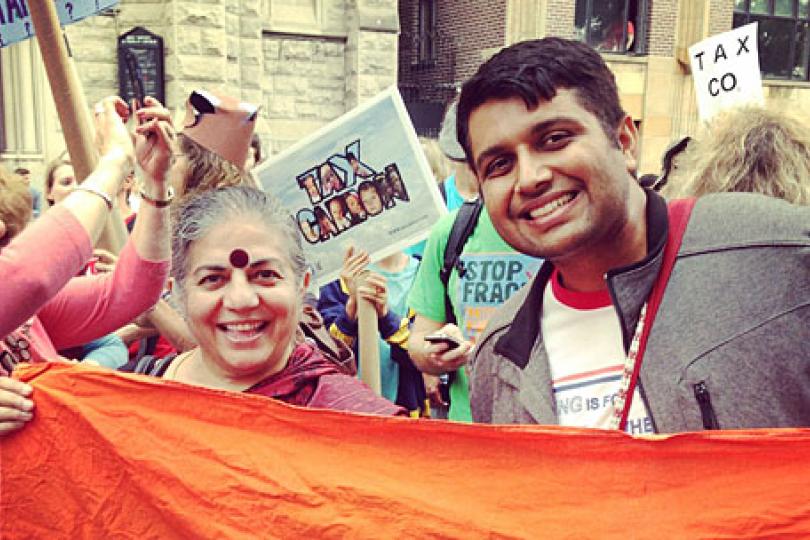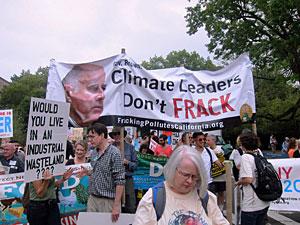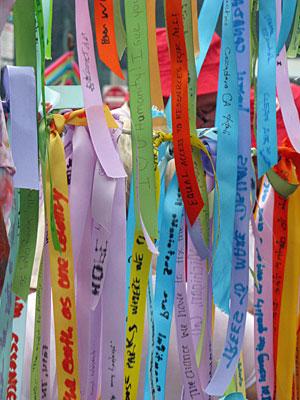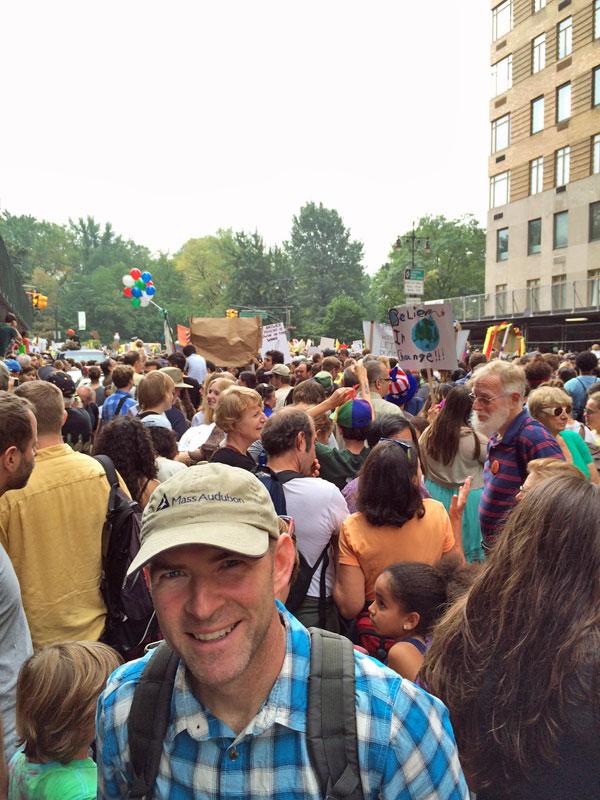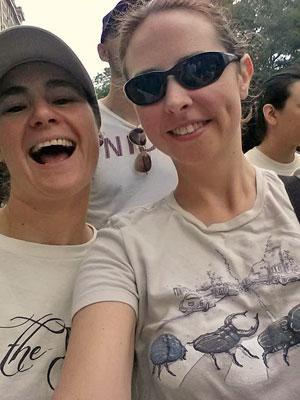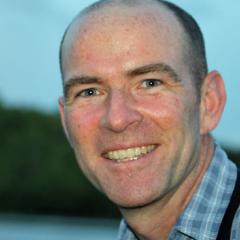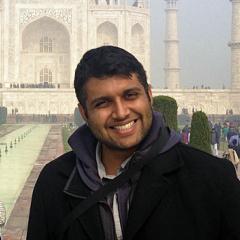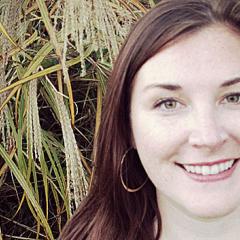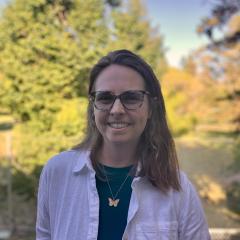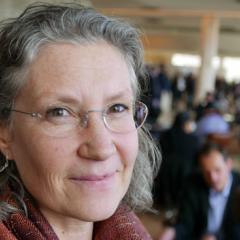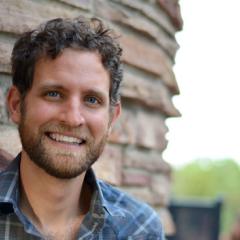Fellows in NYC for People's Climate March
Several Switzer Fellows participated in September's People's Climate March in New York City, just days before the United Nations climate summit. Below are their impressions of the march:
2014 Fellow Kartikeya Singh (pictured above with Vandana Shiva, Indian environmental activist and anti-globalization author), Tufts University:
My favorite part was the hauntingly beautiful moment of silence followed by the wave like roar that reverberated throughout the march sounding the climate alarm. I was happy to march with the front line communities including the South Asians (while representing the Indian Youth Climate Network) and I was personally carrying the flag of India to signal how much the country has to lose from climate change and how much it can gain from taking action.
Note: Kartikeya also spoke with NPR's Here and Now and The Fletcher School recently about the ins and outs of climate change negotiation, as well as goals of the march and UN summit.
2000 Fellow Shaye Wolf, Center for Biological Diversity:
The People’s Climate March was inspirational in turn-out, diversity, and energy. The marchers represented people from all walks of life that are affected by the climate crisis – communities on the front lines, families, people speaking up for the other species we share the planet with – all calling for meaningful action on the local to global scale. I marched with the anti-fracking group between our organization’s banner “Climate Leaders Don’t Frack,” my friend’s 8-year-old daughter carrying her hand-made sign “Save our climate, Animals are dying,” and a parachute that bounced methane bubbles reminding us that fracking can release large quantities of methane that can make fracked natural gas worse for the climate than coal. It was an incredible experience to march with hundreds of thousands of people who are working for positive change and to know there are millions more who want climate action. I came away with a firmer belief that a diverse, vibrant, and outspoken grassroots climate movement is vital to success in tackling the climate crisis, and it’s imperative to keep building this movement.
2000 Fellow and Switzer Board Member Jennifer Sokolove, Compton Foundation:
Sunday was the People’s Climate March. Amazing. Everyone I've talked to keeps using the word 'beautiful' to describe it, which is exactly how it felt to me. The ‘narrative’ arc of the way it was organized, beginning with frontline communities and identifying them as most affected and at the forefront of solutions, moving into labor, then solutions, then resistance to extraction, then science and faith, and finally everyone else, was very powerful. It was by far the most diverse environmental event I’ve ever attended. Not just white by any stretch, and a huge age range, with tons of young people and a pretty high number (all things considered, like canes and wheelchairs) of old people. And the art, the art, was just over the top. It was so colorful and creative and smart and exciting. It kept the positive energy of the march going over hours and hours. I worked on an art installation (Climate Ribbon Project) at the end, went back up the road to watch the march coming down the street, and jumped in about an hour behind the front. After we reached the end, I watched folks coming in for another almost two hours and then walked back home along the route. It was still full of people marching—almost all the way to the park. The sheer scale was overwhelming and intoxicating. It felt historic and hopeful and is already having unexpected ripple effects.
1997 Fellow Jeff Collins, Massachusetts Audubon Society:
My wife and I took the train into the city in the morning and the subway to 72nd St. to join the march. The train from Bedford was crowded even as we got on, and became standing room only by White Plains. Some folks were headed to a Yankees game, but there were lots of groups, couples, and families headed to the march. Knots of out-of-towners were navigating Grand Central and the subway platforms were jammed with marchers – we were treated to a great performance of the Myopic Mermaids who sang of their happy future living in Lower Manhattan, set to Petula Clark’s “Downtown”. Back above-ground we walked east on 72nd to the Dakota, arriving around 11:30, and waited with a growing crowd for the bigger crowd to start moving down Central Park West. It was wall to wall humanity. Lots of singing, chanting, etc. We finally started moving around 1:15. There were lots of chanting, singing, drums, and signs with a huge variety of messages including: climate justice, the debate is over, go vegan, go solar, wind power, tax carbon, give up coal, etc., etc., etc. The mood was impassioned, fun, and hopeful. We cut out at Columbus Circle to make it back to Grand Central for our train home.
As we walked past the break dancers in front of the Plaza and the line in front of the Apple Store, we realized that, no, in fact the whole world had not been paying attention to the march, but it was still well worth the trip.
2013 Fellow Valerie Moye, Yale University:
Last Sunday morning a friend and I piled into a Manhattan metro station; we were already running late to make it to the 11:30 kick-off of the People's Climate March in NYC. We had not yet laid eyes on the crowd that was already gathering several blocks north at Central Park. We had no sense of the magnitude of what we were getting ourselves into.
One by one the metro station filled with quiet groups of marchers, each decked out in colorful shirts and clever signs. One marcher started drumming a slow beat - a rather menacing beat - as we waited for the train. It sounded like a ticking clock. How appropriate to symbolize the state of climate affairs to date. When the train arrived, it was filled to the brim with protesters - the eager faces of moms, dads, babies, grandmas, students, locals, foreigners, a whole rainbow of people peered out at us. There were none of the typical groans or muttered curse words when people realized that nobody would be fitting on that train. Instead the folks on the train platform bust into spontaneous cheers and applause, and the energy was palpable. That is when I knew we were going to be a part of a historic event that would lift the climate dialogue to a new height.
I was most inspired by the groups leading the march, the communities that are already feeling the strain of climate change: Sandy communities, island nations, farmworkers, etc. And of course the youth. At 12:58 the message to take a moment of silence to reflect on those impacted communities rippled through the crowd (from front to back like a game of Telephone in middle school). Two minutes later, the "climate alarm" - 400,000 people screaming in unison for climate action - rippled back from the end to the front of the crowd. That sound rushing toward me was unreal and something I will never forget. Despite the multitude of technology and media outlets disposable to us nowadays, nothing sends a powerful message quite like hundreds of thousands of people gathering in the street.
2011 Fellow Tara Cornelisse (pictured on the right below with her marching beetles tshirt to represent insect biodiversity!), American Museum of Natural History:
The climate march in NYC on September 21st was definitely a political protest, but contrary to other protest marches I have attended, this one felt like a celebration. Upon reflection, I realized that it felt that way because it showed the amazing grassroots movement that has been building around the world to combat climate change. It was the first time that people who have been behind the science, the activism, the policies, and the local and regional actions around the world came together, and we realized that people have been listening and change is happening and we can do this, together. It was a positive and uplifting experience and even if it doesn't make a difference at the national or global level-- which I believe it already is with Obama's recent comments at the UN-- it made a difference at the local level and gave local activists the recognition and hope they need to continue their great work.
2012 Fellow David Ciplet, Brown University:
The People's Climate March was far larger and more powerful than I anticipated. From frontline communities to student groups to neighborhood associations to elders, the marchers demonstrated that climate change is not a fringe issue in the US, and that its time that political leaders act with courage rather than complicity. I came home feeling really energized and ready to get to work.
Additional Resources
Read more about 1991 Fellow Doreen Stabinsky, College of the Atlantic on the U.N. Climate Summit 2014.
Read an op-ed ("Climate threat is mainstream issue") authored by 2012 Fellow David Ciplet in advance of the People's Climate March.
